Composing
Playing Simple Piano Songs Made Easy
Dive into the world of playing simple piano songs with ease, discovering beginner-friendly tunes and essential techniques – unlocking your musical potential.

When starting to play simple piano songs, begin with beginner-friendly tunes and basic chords to lay a strong foundation. These easy melodies help in developing hand coordination, enhancing finger dexterity, and boosting confidence. As you advance, intermediate pieces introduce more complexity in melodies and harmonies, while advanced challenges focus on technical finger exercises and complex chord progressions. 'Fur Elise' is a great piece for beginners to master basic chords. Keep exploring different tunes like 'Twinkle Twinkle Little Star' and 'Jingle Bells' for a mix of familiarity and challenge. More insights await on your musical journey.
Key Takeaways
- Start with beginner-friendly songs like 'Twinkle Twinkle Little Star' for simple piano practice.
- Focus on basic melodies and chords to build a strong foundation in playing easy songs.
- Practice hand coordination and finger dexterity with straightforward tunes.
- Utilize popular beginner tunes such as 'Jingle Bells' for enjoyable learning experiences.
- Consistent practice and patience are key to mastering simple piano songs effectively.
Beginner Piano Songs Selection
When selecting beginner piano songs, prioritize easy melodies and basic chords to build foundational skills effectively. Learning simple piano songs is important for beginners as they provide a solid starting point to understand essential musical elements such as chords and melodies. By practicing these straightforward pieces, beginners can enhance their hand coordination, finger dexterity, and music reading abilities. Additionally, playing beginner piano songs offers a sense of accomplishment and boosts confidence, motivating learners to continue their musical journey.
Choosing easy piano songs that resonate with beginners is key to keeping them engaged and enthusiastic to practice. Popular tunes or familiar melodies can make the learning process more enjoyable and rewarding. As beginners progress and become more comfortable with playing basic chords and melodies, their confidence grows, laying a strong foundation for advancing to more intermediate pieces in the future. Hence, focusing on mastering beginner piano songs is the first step towards becoming a proficient pianist.
Leveling Up: Intermediate Pieces

Moving from beginner piano songs to exploring intermediate pieces introduces greater complexity in melodies, harmonies, and hand coordination. Intermediate pieces offer a stepping stone towards more challenging musical experiences. These songs explore intricate melodies that require a deeper understanding of musical structures and dynamics.
Harmonies become richer, adding layers of depth to the music that can be both rewarding and challenging to master. Hand coordination plays an essential role in intermediate pieces, with both hands often playing different rhythms and melodies simultaneously. As players progress through these songs, they may encounter new techniques that expand their musical repertoire and enhance their playing skills.
Intermediate pieces act as a bridge between the simplicity of beginner songs and the complexity of advanced piano challenges, providing a platform for growth and exploration in the world of music. Embrace the journey of playing intermediate pieces as a means to elevate your musical abilities and broaden your understanding of music.
Advanced Piano Challenges

When tackling advanced piano challenges, we encounter technical finger exercises, complex chord progressions, and valuable musical interpretation tips.
These elements push our skills to new heights, demanding precision, agility, and a deep understanding of musical nuances.
Embracing these challenges with dedication and practice can lead to remarkable growth and mastery in our piano playing journey.
Technical Finger Exercises
How can technical finger exercises in advanced piano challenges enhance dexterity and control? Practicing these exercises can lead to significant improvements in our playing abilities. Here are some key benefits of incorporating technical finger exercises into our practice routine:
- Enhances finger strength and coordination.
- Develops specific skills needed for complex pieces.
- Improves hand movements and finger shifts.
- Refines rhythmic patterns and precision.
Complex Chord Progressions
Exploring the intricate world of complex chord progressions in advanced piano challenges reveals a domain of musical depth and sophistication. These advanced progressions go beyond basic triads, incorporating extended chords, secondary dominants, borrowed chords, and modal interchange. Understanding these elements not only enriches harmonic textures but also elevates the overall musical sophistication of piano performances.
Mastery of complex chord progressions demands practice, ear training, and a solid grasp of harmonic theory. Advanced pianists use these progressions to create intricate harmonic landscapes that convey emotional depth and complexity. Embracing the nuances of advanced chord progressions opens up a domain of creative possibilities, allowing for innovative musical expressions and pushing the boundaries of traditional harmonic structures.
Musical Interpretation Tips
In advanced piano challenges, we hone our skills in musical interpretation by delving into nuanced dynamics, phrasing, and emotional expression. To excel in this domain, consider these key aspects:
- Mastering pedal techniques like sustain, sostenuto, and una corda enhances the depth of your performance.
- Focusing on interpreting complex musical structures, such as key changes and modulations, elevates your playing to a new level.
- Utilizing expressive techniques like rubato, accelerando, and ritardando can add emotional richness and depth to your music.
- Conveying the composer's intentions through your unique artistic expression is a hallmark of advanced piano playing.
Mastering 'Fur Elise'

To tackle mastering 'Fur Elise', aspiring pianists should focus on practicing each hand separately before attempting to combine them. 'Fur Elise' is a classic piece by Beethoven that isn't only iconic but also relatively easy to learn for beginners. This piano song incorporates basic chords, making it a great starting point for those venturing into classical music. By breaking down the piece and practicing each hand independently, learners can build a solid foundation before tackling the challenge of playing them together.
The first section of 'Fur Elise' is particularly beginner-friendly, offering a smooth entry point into the world of classical piano music. As beginners progress, they can gradually work on the more intricate second section, honing their finger dexterity and overall piano playing skills. Patience and consistent practice are essential in mastering 'Fur Elise', but the journey is rewarding, providing a sense of accomplishment and joy as one becomes proficient in playing this timeless composition.
Popular Beginner Piano Tunes
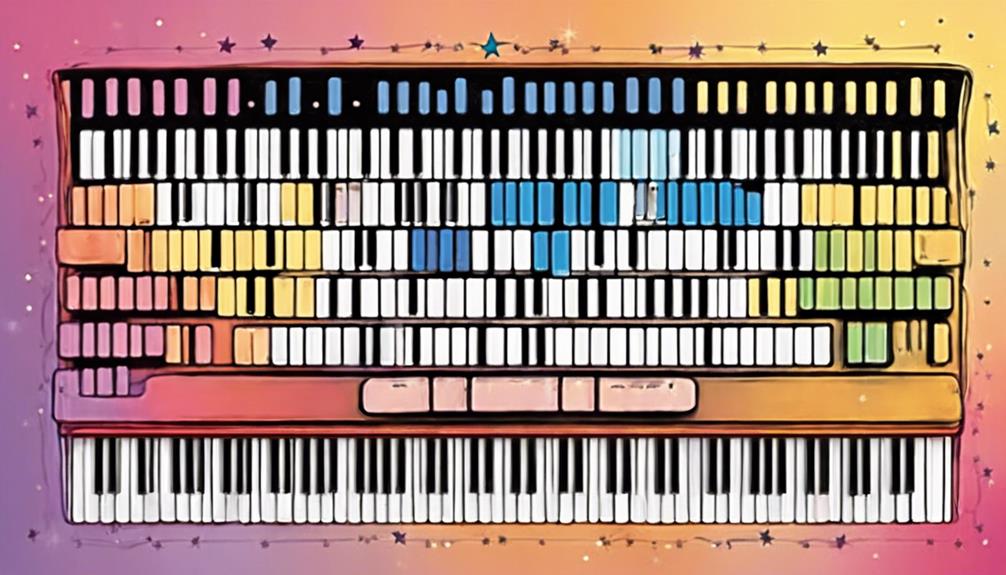
When embarking on the piano, it's crucial to start with easy piano melodies that serve as classic beginner songs. These popular beginner piano tunes, such as Twinkle Twinkle Little Star and Jingle Bells, aren't only enjoyable to play but also help build a strong foundation in piano skills.
Learning these fun piano tunes can be a great way to enjoy the process of mastering the piano.
Easy Piano Melodies
Amidst the plethora of beginner piano tunes, one can't overlook the simplicity and charm of these easy piano melodies that serve as a delightful introduction to playing the piano.
- Twinkle Twinkle Little Star with the right thumb on note C.
- Happy Birthday featuring an octave jump from C to the next C.
- Jingle Bells with lots of repeated notes, familiar to many learners.
- Hallelujah introducing left-hand chords, beautiful and easy for beginners.
These tunes offer a mix of familiarity and challenge, perfect for honing your skills and understanding basic music theory.
Whether you're tapping into the classic melodies of Für Elise or exploring the emotional depth of Hallelujah by Leonard Cohen, these easy piano melodies provide a solid foundation for your musical journey.
Classic Beginner Songs
Classic Beginner Songs, such as Twinkle Twinkle Little Star and Happy Birthday, are popular choices for those starting their piano journey.
Twinkle Twinkle Little Star positions the right thumb on note C for a simple start, while Happy Birthday incorporates an octave jump from C to the next C and introduces a black note (B flat).
For a romantic touch, beginners can try Cant Help Falling in Love, which features a gentle melody and involves playing one note at a time.
These classics provide a solid foundation for learning both the right and left hand techniques essential for mastering piano songs for beginners.
Start with these timeless tunes to build confidence and skill in your musical endeavors.
Fun Piano Tunes
We often enjoy playing beginner piano tunes that are both fun and rewarding for those starting their musical journey. When it comes to fun piano tunes, beginners can learn exciting songs that are easy to follow and perfect for piano lessons.
Here are some popular beginner songs to start playing:
- 'Twinkle, Twinkle, Little Star' – A classic tune with simple finger placements.
- 'Happy Birthday' – An easy song featuring an octave jump and a black note.
- 'Jingle Bells' – A festive favorite with a chorus that's easy to pick up.
- 'Havana' – A fun and slightly challenging song with an off-the-beat rhythm that's rewarding to master.
These fun songs will keep you engaged and motivated while learning to play the piano.
Exploring Classical Piano Repertoire

Exploring the depths of classical piano repertoire reveals a rich tapestry of timeless masterpieces by renowned composers like Beethoven, Bach, and Debussy. These pieces offer a wide range of styles, from the haunting beauty of 'Clair de Lune' to the iconic power of 'Moonlight Sonata.' Learning classical repertoire not only helps in developing technical skills but also enhances musical interpretation and historical appreciation. Pieces like 'Fur Elise' and 'Gymnopédie No. 1' are popular choices for pianists at intermediate skill levels. Engaging with classical piano repertoire allows for the exploration of diverse musical emotions and expressions.
| Piano Songs to Learn | Classical Repertoire | Easy to Learn |
|---|---|---|
| Fur Elise | Clair de Lune | Moonlight Sonata |
| Gymnopédie No. 1 |
Exploring classical piano repertoire opens the door to a world of musical innovation and creativity. It challenges pianists to immerse themselves in the nuances of each piece, honing their skills while expressing their unique artistic interpretations.
Easy Piano Songs for Practice

Easy piano songs for practice provide beginners with accessible and enjoyable pieces to enhance their skills and musical understanding. Here are some easy songs for piano players to start learning:
- Twinkle Twinkle Little Star: A popular choice for young students, this song is simple and delightful.
- Jingle Bells: With a chorus that's easy to learn and lots of repeated notes, this song is perfect for beginners.
- Happy Birthday: This song is straightforward, with the right thumb starting on note C, making it a great piece for practice.
- Hallelujah: Introducing left-hand chords, this beautiful song is easy to learn and perfect for beginners looking to develop their skills.
These songs offer a range of styles and levels of difficulty, allowing piano players to practice and improve their skills while enjoying the music they're playing.
Frequently Asked Questions
What Is the Easiest Song to Play on the Piano for Beginners?
When looking for the easiest song to play on the piano as a beginner, 'Twinkle Twinkle Little Star' is a classic choice. It involves simple hand placement and a repetitive melody, making it accessible for those starting out.
What Notes Are Easy to Play on Piano for Beginners?
Middle C, along with notes in the C major scale like G and F, are beginner-friendly on the piano. Basic chords such as C major, G major, and F major are easy to grasp.
Simple melodies with stepwise motion help beginners in playing and remembering tunes. Familiar songs like nursery rhymes and folk melodies often feature easy-to-play notes.
Starting with these notes and chords can make learning the piano more accessible and enjoyable for beginners.
What Is the Easiest Way to Learn a Piano Song?
The easiest way to learn a piano song is by breaking it down into smaller sections and practicing them regularly. Focus on hand coordination and rhythm while using online tutorials and apps for guidance.
Choose a simple song with clear melodies and basic chords. By practicing efficiently and building muscle memory, you can improve your playing skills.
What Is That One Piano Song That Everyone Knows?
When it comes to piano songs that everyone knows, one classic that stands out is “Happy Birthday.” Its universal appeal makes it a popular choice for gatherings and celebrations.
The catchy melody and simple structure make it easy for beginners to learn and play. It's a great starting point for those looking to build their piano skills while also bringing joy to others through music.
Conclusion
To sum up, playing simple piano songs can be like painting with broad strokes on a blank canvas – a beautiful way to express oneself through music.
Whether you're a beginner just starting out or an advanced player looking for a new challenge, there's a wide range of songs to explore and enjoy.
So, grab your sheet music, sit at the piano, and let the music flow from your fingertips. Happy playing!
Composing
How to Make AI Songs: Crafting Melodies in 5 Steps
Prepare to unlock the potential of AI-generated music with five key steps – a journey of creativity and enchanting melodies awaits!

Crafting AI-generated music involves selecting a music generation tool that suits your needs. Input descriptive prompts specifying emotions, genres, and more for the AI to create melodies. Experiment with parameters like temperature and seed options. Once a song is generated, optimize it by fine-tuning model parameters and exploring melody transformations. Use tools like FFmpeg for refinement. These steps will help tailor unique and enchanting musical creations. Each stage contributes to the evolution of your AI-generated music. Further insights await on enhancing your melodies in this creative journey.
Key Takeaways
- Input descriptive prompts specifying emotions, genres, and more for AI guidance.
- Experiment with parameters like temperature and seed options for varied styles.
- Optimize generated songs by fine-tuning model parameters for style influence.
- Explore melody transformations like transposition, ornamentation, and harmonies.
- Utilize tools for refining, such as FFmpeg and Audacity, to enhance AI music.
Selecting a Music Generation Tool
When selecting a music generation tool, assess its features, ease of use, and compatibility with our system to align with our creative goals. An important aspect to ponder is the ease of use, as it can greatly impact our workflow and productivity in content creation. Look for tools that offer a user-friendly interface, allowing seamless navigation through different instruments and audio files.
The ability to easily manipulate parameters and customize prompts can enhance our creative process and streamline the generation of music. Additionally, compatibility with our existing system is vital to guarantee smooth integration of the tool into our workflow for efficient music production. By selecting a tool that prioritizes ease of use and compatibility with our system, we can focus more on our creative vision and exploration of new musical possibilities.
Inputting Descriptive Prompts

In crafting AI songs, we start by inputting descriptive prompts that guide the AI in generating melodies aligned with our preferences. These prompts serve as the foundation for the AI to understand the style, mood, and structure we desire in the music.
By specifying details like emotions, genres, time signatures, and beats per minute, we provide the AI with a clear roadmap to create melodies that resonate with our musical taste. It's crucial to be specific in our prompts, especially if it's our first time using such a tool, as this input greatly influences the output we receive.
Mixing different elements in the prompts can lead to the creation of unique and diverse musical compositions, allowing us as content creators to explore new avenues of creativity. Including parameters such as tempo and mood can shape the style and tone of the AI-generated melodies, making each minute-long piece distinct and tailored to our preferences.
Experimenting With Parameters
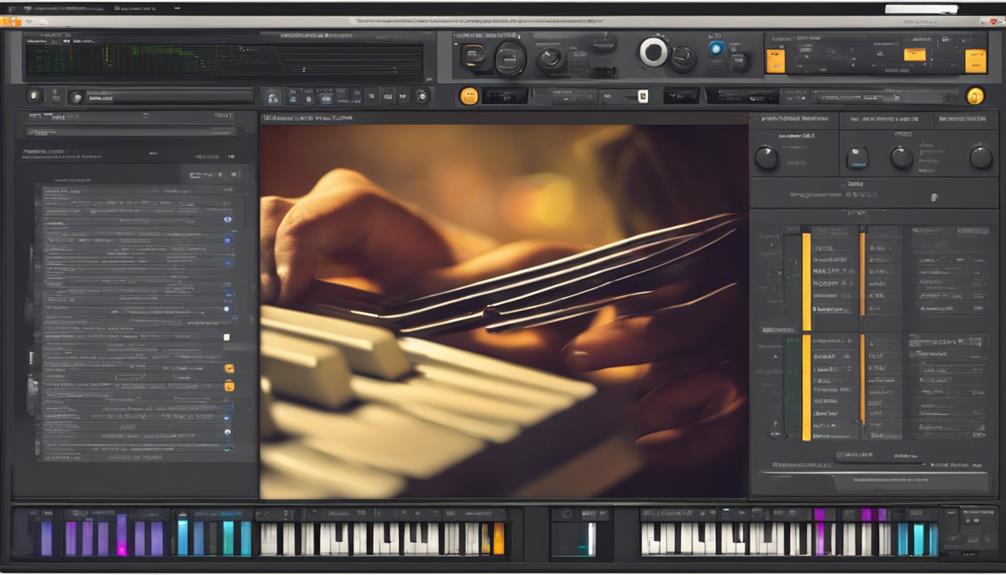
To enhance the creative output of AI-generated melodies, we can manipulate parameters such as temperature, window slider, and seed options within MusicGen. Here are some ways to experiment with these parameters:
- Adjusting Temperature: By modifying the temperature setting, we can control the level of randomness in the generated melodies. A higher temperature leads to more unpredictable and diverse outcomes, while a lower temperature yields more structured and familiar melodies.
- Exploring Window Slider: The window slider enables us to fine-tune the size of the window that the AI considers when generating each note. Adjusting this parameter can influence the continuity and coherence of the melodies produced.
- Utilizing Seed Options: Changing the seed options can have a significant impact on the starting point of the AI's creative process. By experimenting with different seeds, we can guide the AI towards generating melodies with varying styles and characteristics.
- Fine-Tuning Parameters: Explore the details of time signatures, beats per minute, and sampling techniques to uncover a plethora of creative possibilities. By refining these parameters, we can steer the AI towards crafting melodies that align with our desired musical vision.
Optimizing Generated Songs
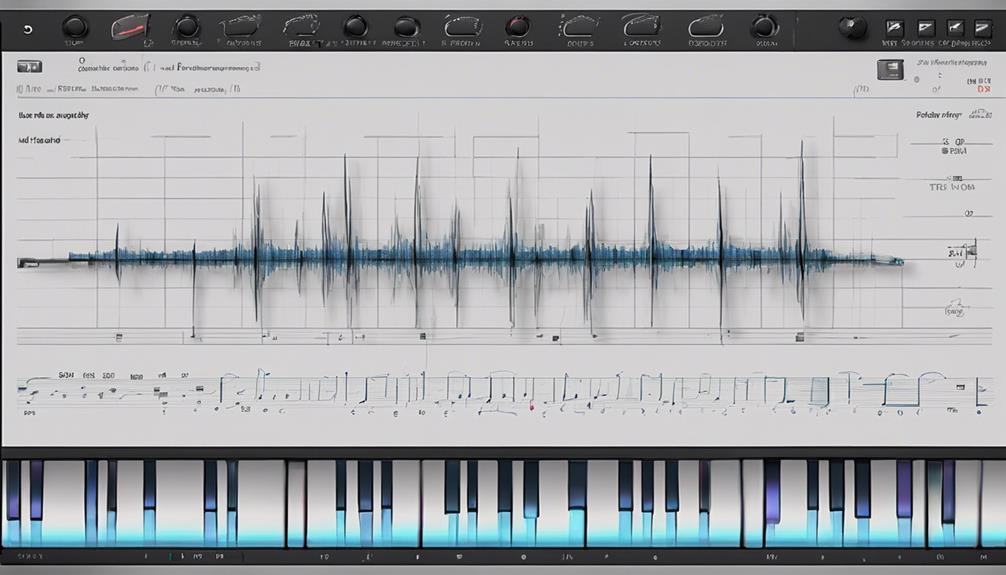
Fine-tune model parameters like temperature and seed options to optimize the creativity and randomness of generated songs. By adjusting these settings, you can influence the style and originality of the AI-generated music.
Experiment with different melody transformations to explore diverse musical possibilities and enhance the quality of the compositions. Utilize tools like FFmpeg and Audacity to refine the generated songs further, extracting unique elements and refining the overall sound.
Understanding how AI music generation parameters such as time signatures, beats per minute, and sampling techniques impact the output is essential for achieving desired results. By delving into these details, you can fine-tune the AI music generation process to align with your creative vision.
Embrace the opportunity to explore and optimize these parameters to craft truly innovative and alluring AI-generated songs that reflect your unique musical preferences.
Exploring Melody Transformations

Exploring various melody transformations can greatly enhance the creativity and uniqueness of AI-generated music compositions. When delving into melody transformations, consider the following techniques to elevate your musical pieces:
- Transposition: Shifting a melody to a different key can evoke various emotions and alter the overall mood of the composition.
- Ornamentation: Adding embellishments like trills, grace notes, or mordents can inject flair and intricacy into the melody, making it more enchanting.
- Harmonies: Layering harmonies can enrich the depth of a melody, creating a lush and harmonically rich sound that resonates with listeners.
- Rhythmic Variations: Experimenting with tempo changes, syncopation, and rhythmic patterns can infuse dynamism and energy into the melody, keeping the listener engaged throughout the piece.
Frequently Asked Questions
How Do You Make Music With Ai?
When making music with AI, we utilize tools like MusicGen to generate melodies from text prompts. By experimenting with various models and parameters, we tailor the AI-generated music to our preferences.
Exploring different prompts such as emotions, genres, and musical elements like time signatures and beats per minute allows for creative output. Fine-tuning is done by adjusting parameters like temperature, window slider, and seed options.
Incorporating favorite melodies and transforming songs into different genres enhances creativity.
How Do You Make a Melody for a Song?
When making a melody for a song, we start by selecting a key and time signature to establish the musical framework.
Then, we experiment with note lengths, intervals, and rhythms to craft a memorable and engaging melody. Repetition and variation help structure the melody, making it cohesive and recognizable.
By considering the desired emotional impact, we adjust notes accordingly.
Can AI Recreate Music?
Yes, AI can recreate music by analyzing patterns in existing songs and generating new melodies based on trained algorithms. Neural networks and machine learning models enable AI to understand music structures and create original compositions.
With tools like MusicGen using deep learning techniques, AI can mimic various music styles and genres, producing compositions that sound like they were made by human musicians. This opens up possibilities for innovative musical creations in different genres.
What Is the AI for Singing Songs?
AI for singing songs utilizes advanced algorithms to generate vocal melodies and lyrics. This technology can analyze existing songs, learning patterns and styles to create original compositions.
It simulates various vocal styles, from pop to classical, and users can input text prompts or melodies to guide the AI. This evolving AI offers endless possibilities for music creation and innovation, revolutionizing the way we approach songwriting and music production.
Conclusion
In crafting AI-generated melodies, we've learned to navigate music generation tools, input descriptive prompts, experiment with parameters, optimize songs, and explore melody transformations.
Like a skilled composer shaping a symphony, we can harness the power of technology to create unique and mesmerizing tunes.
With practice and innovation, the possibilities for AI-generated music are endless.
Composing
10 Steps to Mastering the Art of Sampling Songs
Yearning to elevate your music production? Dive into '10 Steps to Mastering the Art of Sampling Songs' for expert tips and techniques.

Start mastering the art of sampling songs with these steps: Understand the basics – use existing music creatively. Choose samples wisely – think genre, style, and novelty. Experiment with slicing for originality – Fruity Slicex is great for precision. Utilize tools like Ableton Live for advanced editing. Enhance samples with effects – reverb, distortion, delay, and pitch shifting work wonders. Layer sounds for depth, utilizing EQ and panning for clarity. Adjust tempo and pitch seamlessly for a polished sound. Be creative – play with key and time-stretching for unique tones. Consider legalities and fair use guidelines. Collaborate for fresh perspectives and unique creations.<path>To discover more about mastering sampling, explore our detailed guide.
Key Takeaways
- Experiment with diverse genres for unique samples.
- Master slicing techniques for creative compositions.
- Layer samples for depth and complexity.
- Adjust tempo and pitch to fit your project.
- Understand and comply with legal sampling guidelines.
Understanding Sampling Basics
Understanding the fundamentals of sampling is essential for any music producer looking to create innovative and legally sound compositions. Sampling involves extracting or using a portion of a pre-existing song or sound recording in a new composition. It allows us to create unique sounds by manipulating and reimagining existing audio material. Sampling provides a creative way to incorporate diverse musical elements into a track, adding depth, texture, and nostalgia to our music productions.
When sampling, it's important to be aware of the legal implications to avoid copyright infringement. By understanding the boundaries and permissions required when using samples, we can guarantee that our compositions aren't only innovative but also legally compliant. Sampling opens up a world of possibilities for music producers to experiment with different genres, styles, and eras, creating dynamic and compelling tracks that resonate with listeners on a deeper level. Mastering the art of sampling isn't just about technical skill but also about creativity and understanding the nuances of blending old and new sounds seamlessly.
Selecting the Right Samples

When it comes to crafting compelling music compositions through sampling, the initial step lies in carefully selecting the right samples that align with the desired genre, style, and sonic direction of your project. Here are some key points to contemplate:
- Genre and Style: Begin by contemplating the genre and style of music you aim to create. Different genres may require samples from various sources to achieve the desired vibe.
- Unique Textures and Melodies: Seek out samples that offer unique textures, melodies, or rhythms to help your production stand out. Experimenting with unconventional sounds can lead to innovative results.
- Exploring Different Sources: Don't confine yourself to one source for samples. Explore vinyl records, online sample packs, and music libraries to discover hidden gems that can elevate your music.
Experimenting With Slicing Techniques

Exploring various slicing techniques can enhance the intricacy and creativity of your sampled music compositions. By utilizing slicing plugins such as Fruity Slicex, you can chop samples into individual segments for precise editing. Experiment with different chop patterns and arrangements to create unique rhythmic structures that add depth to your music. Take advantage of auto-slice features in plugins to streamline your workflow and efficiently arrange your samples.
Recording and playing back chopped samples can help you maintain your creative flow and explore different configurations to find the perfect fit for your composition. Creating new patterns for each chop can build dynamic beats and elevate the overall quality of your music. Embrace the flexibility that slicing techniques offer, allowing you to push the boundaries of traditional sampling and craft innovative soundscapes that captivate your audience.
Mastering Audio Editing Tools
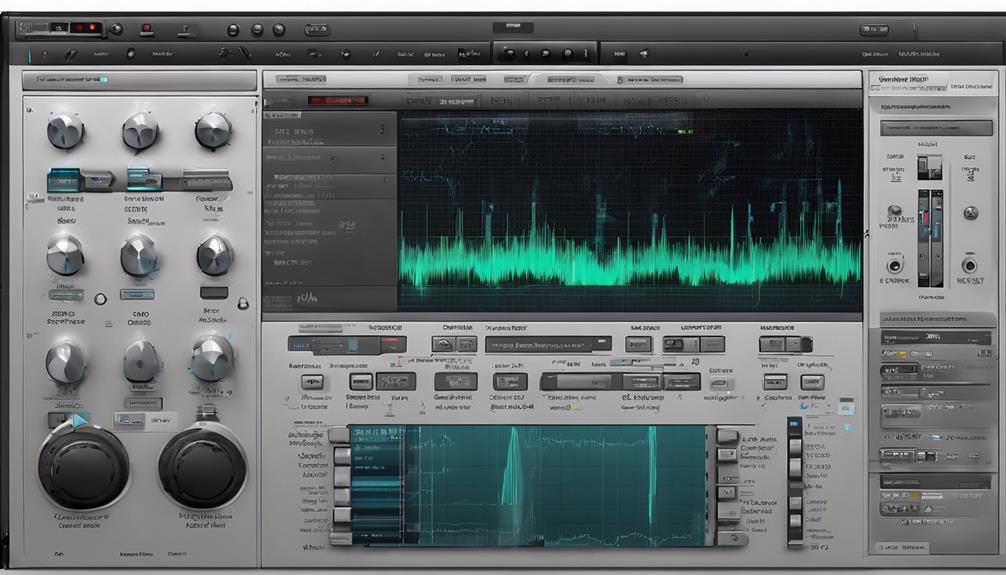
Let's explore mastering essential audio editing tools to enhance our sampled music compositions. When it comes to audio editing tools, there are several key techniques to focus on:
- Utilize Advanced Features: Investigate tools like Ableton Live's Simpler and Sampler for precise manipulation of samples. These advanced features allow for detailed editing and customization, helping to create unique and dynamic compositions.
- Experiment with Editing Functions: Learn to use editing features such as crossfading, time-stretching, and pitch shifting to seamlessly integrate samples. These functions are essential for achieving a professional sound and ensuring that samples blend harmoniously within your tracks.
- Master Layering Techniques: Understand how to layer samples using blending modes, envelopes, and modulation to create rich and textured soundscapes. By mastering these techniques, you can add depth and complexity to your compositions, elevating your music to new heights.
Enhancing Samples With Effects
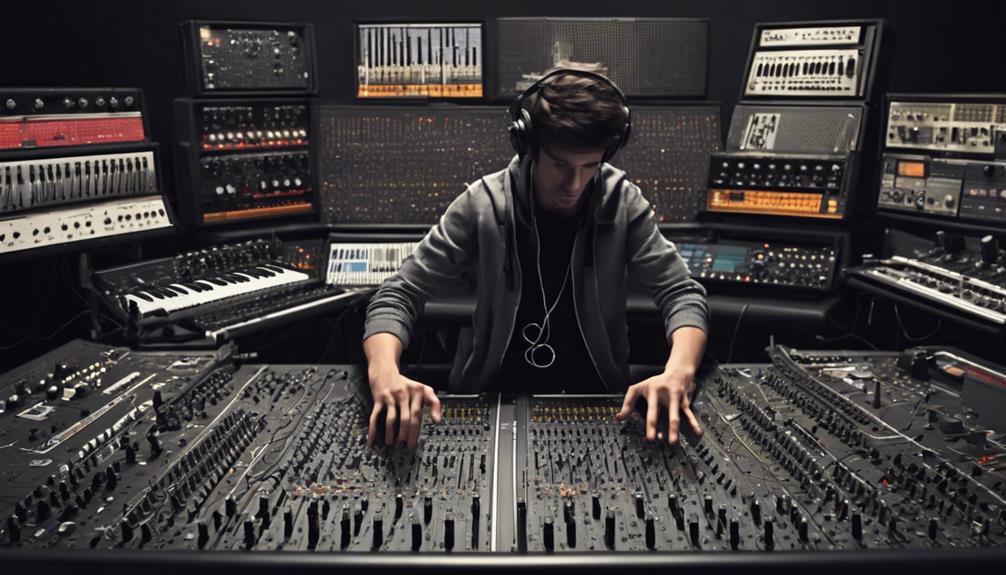
To enhance our sampled music compositions further, we can explore incorporating various effects to elevate the depth and texture of our samples. One powerful effect to experiment with is reverb, which adds space and depth to samples, creating a sense of ambiance and immersion. By adjusting the reverb settings, we can make our samples sound like they are being played in different acoustical environments, from tight rooms to vast concert halls.
Here is a table showcasing different effects that can enhance our sampled music compositions:
| Effect Type | Description | Example |
|---|---|---|
| Reverb | Adds space and depth to samples, creating ambiance | Simulating a concert hall |
| Distortion | Adds grit and character to sampled sounds | Creating a raw, edgy tone |
| Delay | Creates echoes and rhythmic patterns in samples | Emulating a spacious feel |
| Pitch Shifting | Alters the pitch of samples for creative effects | Creating unique melodies |
Experimenting with these effects can help us transform our samples and take our music compositions to new heights of creativity and innovation.
Layering Samples for Depth
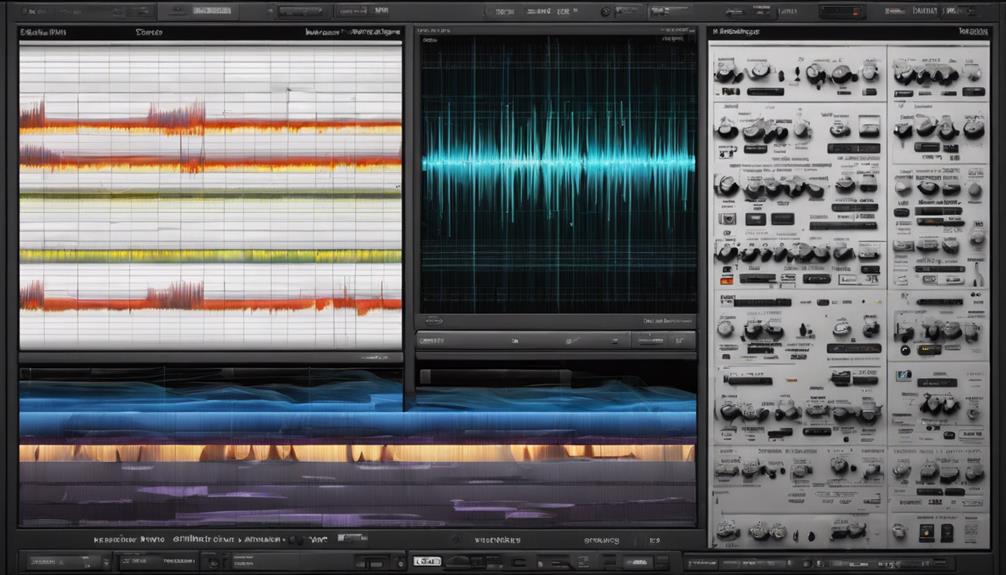
How can layering samples enhance the depth and complexity of music compositions?
Layering samples allows us to blend multiple sounds seamlessly, creating a rich and dynamic sonic experience.
Here are three ways to make the most of layering samples:
- Experiment with Complementary Samples: Combine samples that not only sound good individually but also complement each other in tone, texture, and rhythm. This blending can add layers of complexity and interest to your music.
- Utilize EQ and Panning Techniques: Position each layered sample effectively in the mix using EQ to carve out space for each sound and panning to create a balanced sonic landscape. This technique helps prevent muddiness and ensures clarity in your composition.
- Achieve Uniqueness and Personalization: By strategically layering samples, you can create a distinctive sound that sets your music apart. This personalized touch can help you establish a unique identity in the music industry and captivate your audience with innovative compositions.
Adjusting Tempo and Pitch

When adjusting tempo and pitch in sampling, we aim to seamlessly blend the sample's BPM with our project tempo and harmonize the pitch with our track's key.
By utilizing time-stretching tools, we can alter the sample's duration without impacting its pitch, creating unique effects.
Experimenting with various tempo and pitch combinations allows for creative exploration and fine-tuning to achieve a polished and cohesive sound in our sampled tracks.
Tempo Manipulation Techniques
Adjusting tempo and pitch in sampling songs can greatly impact the overall sound and cohesion of the music composition. When delving into tempo manipulation techniques, consider the following:
- Syncing Elements: Adjusting tempo allows for aligning sampled elements with the project tempo, ensuring a seamless blend of sounds.
- Tonality Alteration: Pitch shifting can transform the tonality of samples, introducing unique textures and harmonies to the composition.
- Enhanced Musicality: Matching the tempo and pitch of samples to the project enhances the overall musicality, elevating the listening experience to new heights.
Exploring various tempo and pitch adjustments through tools like time-stretching can lead to innovative and engaging musical outcomes, offering endless possibilities for creativity.
Pitch Shifting Methods
Exploring pitch shifting methods in sampling songs involves manipulating the musical key of samples without affecting their tempo, opening up avenues for creative tonal adjustments.
Pitch shifting tools, such as Ableton Live's Complex Pro, maintain sample quality during pitch alterations, allowing producers to experiment with different musical keys seamlessly.
Additionally, time-stretching plugins like Pro Tools' Elastic Audio enable tempo modifications while preserving the integrity of the sample's pitch.
By combining pitch shifting and time-stretching techniques, producers can create unique and diverse sounds in sampled music production.
These methods offer a way to innovate within the domain of music production, providing opportunities for artists to explore new sonic possibilities and push the boundaries of traditional sampling practices.
Legal Considerations in Sampling

Understanding copyright laws is essential when sampling songs to steer clear of legal trouble.
It's important to remember the necessity of sample clearance for commercial use of copyrighted material in your music.
Utilizing royalty-free samples can be a smart way to prevent copyright infringement while sampling songs.
Copyright Laws for Sampling
Understanding copyright laws for sampling is essential in the music industry to avoid legal implications. When it comes to sampling, here are three key points to keep in mind:
- Clearance Requirement: Copyright laws protect original music, necessitating clearance for sampling copyrighted material to avoid infringement.
- Commercial Use: Obtaining sample clearance is important for commercial music projects to prevent legal issues that could arise from unauthorized sampling.
- Legal Alternatives: Royalty-free samples offer a necessary route for producers seeking to sidestep clearance concerns, providing a safer option for incorporating samples into their work.
Fair Use Guidelines
When exploring the legal landscape of sampling in music production, it is important to take into account the Fair Use Guidelines as they determine the permissible boundaries for using copyrighted material. Fair use guidelines allow for limited use of copyrighted material for purposes such as criticism, comment, news reporting, teaching, scholarship, or research. Sampling copyrighted material without permission can lead to legal issues such as copyright infringement and potential lawsuits. Fair use factors, such as the purpose and character of the use, the nature of the copyrighted work, the amount and substantiality of the portion used, and the effect on the market, determine the legality of sampling. Understanding these nuances is essential for producers to navigate the complexities of fair use guidelines and copyright law.
| Fair Use Guidelines | Description |
|---|---|
| Limited use | Allows for specific purposes like criticism and research |
| Factors | Purpose, nature, amount, and effect on the market |
| Legal implications | Copyright infringement and potential lawsuits |
| Importance | Essential for producers to navigate sampling complexities |
| Commercial use | Requires sample clearance to avoid legal consequences |
Obtaining Sample Clearance
Securing sample clearance is an essential step in the music production process to avoid legal complications. When it comes to obtaining sample clearance, there are a few key points to keep in mind:
- Legal Compliance: Ensuring that you have the proper sample clearance is important to avoid potential legal issues down the line.
- Negotiation: Engaging in discussions with rights holders is a common practice when seeking sample clearance.
- Financial Implications: Be prepared to potentially pay licensing fees as part of the sample clearance process.
Understanding the importance of sample clearance and the steps involved in obtaining it's crucial for any music producer looking to use samples in their work.
Cultivating Creativity in Sampling

To foster creativity in sampling, producers can experiment with combining samples from diverse genres to craft fresh and innovative sounds. By exploring various sampling techniques, such as time-stretching, chopping, and layering, producers can push the boundaries of traditional music production and create unique sonic landscapes. Sampling serves as a powerful tool for inspiration, allowing for the seamless integration of different musical elements to spark new ideas and directions in composition. This approach not only enhances the richness of the music but also sets the stage for groundbreaking creations.
Furthermore, incorporating live instrumentation alongside samples can elevate the depth and complexity of a track, adding a layer of authenticity and organic texture. Developing a distinct sampling style involves continuous experimentation with different techniques and approaches, aiming to carve out a signature sound that sets producers apart. By embracing innovation and constantly challenging conventional practices, producers can cultivate their creativity in sampling, opening doors to endless possibilities in music production.
Collaborating for Unique Sounds

Collaboration with fellow producers can introduce fresh sample sources and offer new perspectives on manipulating samples, leading to the creation of unique sounds. When collaborating for unique sounds, consider the following:
- Diversify Your Network: Engage with producers who've diverse sampling styles to expand your creative horizons and bring fresh ideas to the table.
- Utilize Live Recordings: Incorporating live recordings from musicians and vocalists can infuse your samples with a human touch, adding depth and authenticity to your music.
- Community Support: Building a network of collaborators creates a community where you can exchange feedback, learn new techniques, and enhance your sampling skills collaboratively.
Frequently Asked Questions
How Do You Sample Music Effectively?
To sample music effectively, we start by selecting high-quality source material with clear instrumentation. Experiment with different chopping techniques like manual slicing and auto-slicing.
Utilize pitch shifting and time-stretching tools for tempo matching. Layer multiple samples for depth and texture. Apply effects strategically for creative transformation.
What Is the Rule for Sampling Music?
The rule for sampling music involves obtaining permission from the original copyright owner. Sampling without permission can lead to legal issues like copyright infringement and lawsuits. Clearing samples requires negotiating with rights holders, obtaining licenses, and paying royalties.
Fair use exceptions may apply, allowing limited use of copyrighted material for criticism, commentary, or parody. Understanding this legal framework is essential to avoid legal consequences and protect creative work.
What to Do Before Sampling a Song?
Before sampling a song, we must research legalities to guarantee compliance with copyright laws.
Listening to the original track helps grasp its structure and elements. Identifying the specific section to sample focuses our creativity. Considering tempo and key alignment is vital.
What Are the Sampling Techniques in Music Production?
Sampling techniques in music production involve various processes such as slicing samples, pitch shifting, time-stretching, and layering for depth. These tools help us create unique sounds by repurposing existing audio.
By mastering these techniques, we can blend genres, rhythms, and textures to craft innovative music. Slicing plugins, AI-powered samplers, and effects processors are essential in shaping sampled sounds.
Understanding these methods allows us to seamlessly blend old and new elements in our tracks.
Conclusion
In mastering the art of sampling songs, remember to keep experimenting, learning, and pushing your creative boundaries.
With dedication and practice, you can transform simple samples into complex, unique creations that truly stand out.
So, go ahead and immerse yourself in the world of sampling with confidence and passion.
The possibilities are limitless, and the journey to mastering this craft is a thrilling adventure waiting to unfold.
Composing
Mastering the Art of Song Mashups in 10 Simple Steps
Kickstart your journey to mastering song mashups with 10 simple steps for creating seamless and captivating mixes.

When mastering song mashups in 10 steps, begin by selecting compatible tracks in key and tempo. Harmonize songs in genre and style, creating a cohesive blend for engaging mixes. Align beats precisely and use beat matching tools for seamless progressions. Create a rough mix, adjusting levels and experimenting with connections. Enhance with effects like reverb and progressions for a professional touch. Test on various systems and seek feedback for improvement. Pay attention to detail—matching key and perfecting connections. Embrace creativity in merging vocals and instruments. Each step refines your mixing skills, leading to polished, innovative mashups.
Key Takeaways
- Select compatible songs in key, tempo, and genre.
- Align beats and tempo for seamless transitions.
- Create a rough mix to blend tracks cohesively.
- Add effects and transitions for a unique touch.
- Adjust sound levels for a polished sound.
Selecting Compatible Songs
When crafting a successful mashup, our initial step involves carefully selecting songs that harmonize in key and tempo for a seamless blend. Matching or compatible keys are vital to guarantee that the shift between tracks is smooth and pleasing to the ear. By considering the tempo and rhythm of the songs, we can create a cohesive fusion that captivates our audience and keeps them engaged throughout the mashup experience.
It is essential to choose songs that complement each other not only harmonically and rhythmically but also in genre, style, and overall feel. This compatibility enhances the unity of the mashup and contributes to a more enjoyable listening experience for our audience. Additionally, mixing popular and recognizable tracks can add an element of familiarity that resonates with listeners and makes the mashup more appealing.
Selecting compatible songs and understanding how they work together is the foundation of creating a successful mashup that flows seamlessly from one track to the next. By curating a thoughtful selection of songs, we can elevate our mashup to new heights of creativity and innovation.
Aligning Beats and Tempo
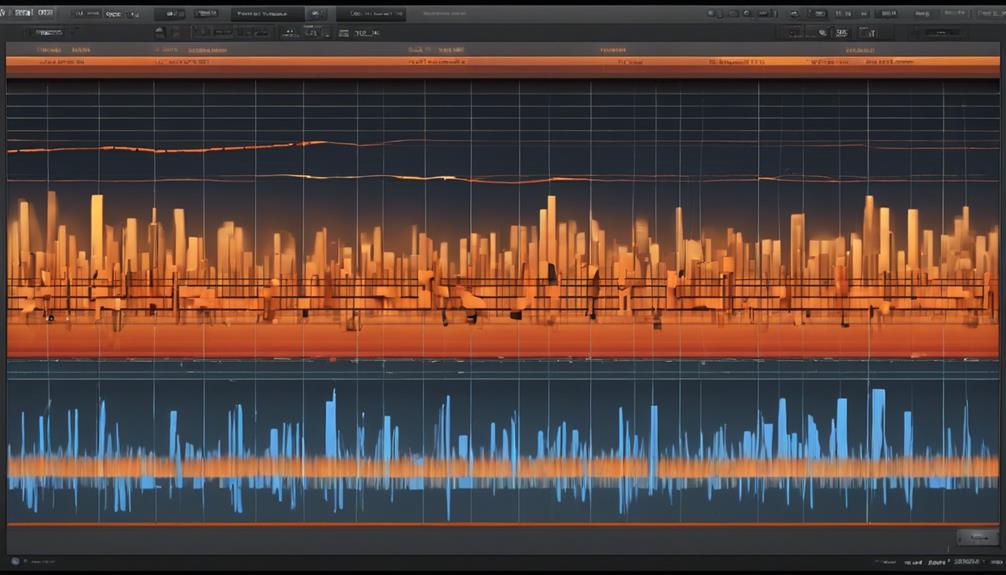
Properly aligning beats and tempo is fundamental in ensuring a seamless shift between songs in a mashup. When mixing music to make mashups, matching beats and tempo is like weaving a tapestry of sound where each thread complements the other.
Utilize the beat matching tools in your digital audio workstation to synchronize each beat precisely. Adjusting the tempo of tracks is key to aligning them for a smooth and continuous flow in your mashup creation.
This beat alignment not only maintains the energy and rhythm throughout the mix but also elevates the overall listening experience. Consistent tempo matching is the secret ingredient that enhances the fusion of different tracks into a harmonious blend.
Creating a Rough Mix
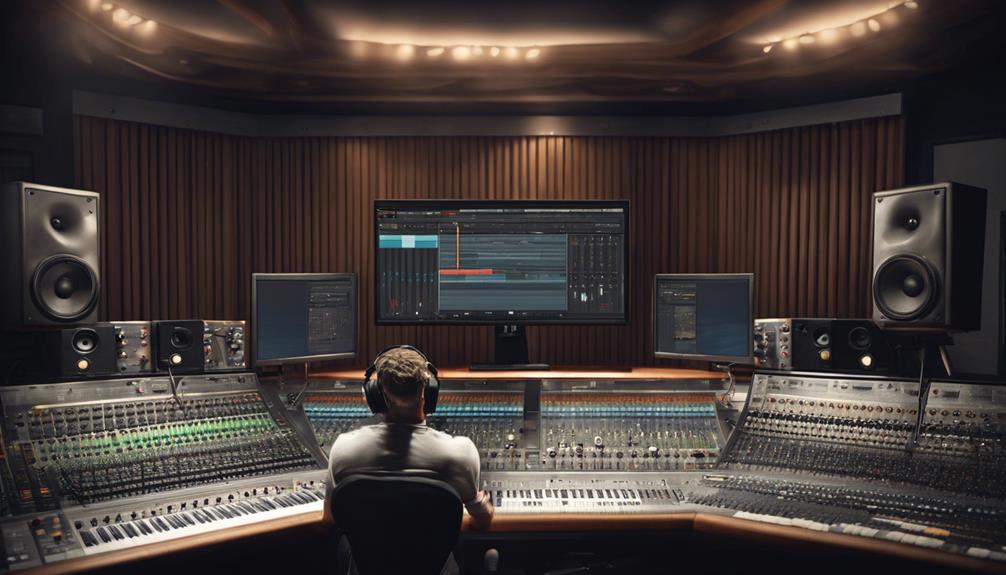
In crafting a rough mix for a mashup, our focus lies on laying the groundwork for the final seamless amalgamation of tracks. This pivotal stage in music production involves aligning the different songs, adjusting levels, and guaranteeing a coherent blend between them.
By creating a rough mix, we set the stage for the overall structure of the mashup, allowing us to experiment with various song combinations and connections. This phase is essential in the mixing process as it helps us identify any potential issues early on and refine the overall sound of the mashup. It serves as a foundation upon which we can build and perfect a high-quality final product.
Through careful manipulation and adjustment during this stage, we can ensure that the tracks flow seamlessly into each other, setting the stage for the next steps in the music production process.
Adding Effects and Transitions

When creating your mashup, it's essential to improve audio quality by using effects like reverb, delay, and filters. These tools not only aid in forming smooth shifts between songs but also provide a creative edge to your mix.
Trying out reverse effects, stutter effects, and pitch modulation can add a distinct touch to your shifts, making your mashup stand out.
Enhancing Audio Quality
Enhancing the audio quality of a mashup involves adding effects and enhancements to elevate the overall sound experience. By incorporating cool effects like reverb, delay, and filters, you can take your mashup to the next level. These effects can add depth and dimension to the tracks, creating a more immersive listening experience. Additionally, utilizing EQ adjustments and compression can help balance frequencies and control dynamics, ensuring a polished sound. To enhance creativity, consider incorporating unique effects such as stutter edits or pitch manipulation for a fresh and innovative touch. Here is a table showcasing some popular effects and enhancements used in the Art of Mixing:
| Effects | Enhancements |
|---|---|
| Reverb | EQ adjustments |
| Delay | Compression |
| Filters | Stutter edits |
| Pitch manipulation | Creative impacts |
Seamless Transitions Between Songs
With a seamless blend of effects and connections, we can elevate the fluidity and cohesion between songs in a mashup. By using tools like reverb, delay, and filters, we can create smooth shifts that keep the energy flowing.
Experimenting with crossfading, echo, and phasing effects adds depth and continuity to your shifts, making mashups more engaging. Incorporating risers, sweeps, and drops builds anticipation and excitement as you move between tracks.
Utilize beat slicing and stutter effects for dynamic shifts that keep listeners hooked. Layering vocals or instrumentals from one song over another's ending helps seamlessly blend different tracks. These techniques are key to making mashups with smooth shifts that captivate your audience.
Creative Use of Effects
We can enhance mashup creations by skillfully incorporating various effects to add depth and character to the sound. Adding effects such as reverb, delay, and filters can greatly elevate the mix of a song, creating a more dynamic and engaging listening experience.
These effects not only enhance individual audio files but also play an essential role in seamlessly shifting between different song segments. Shift effects like risers, sweeps, and impacts can help blend tracks together smoothly, maintaining the flow of the mashup.
Adjusting Sound Levels
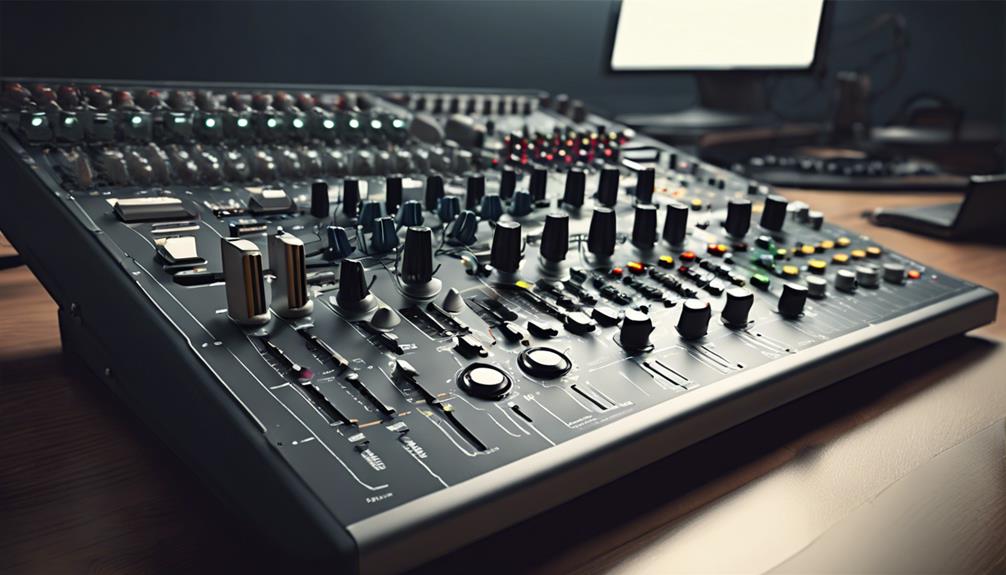
Balancing sound levels in a mashup mix is essential for creating a seamless and harmonious blend of different tracks. When working with new songs, adjusting sound levels becomes important to make sure that each element shines through while maintaining a cohesive sound.
Using audio editing software allows us to fine-tune the volume of vocals, instruments, and effects in the mashup. It's important to pay attention to the dynamics of each track to avoid clipping or distortion when adjusting sound levels. Experimenting with different volume settings is key to achieving a professional and polished sound in your mashup.
Mastering the Final Mix
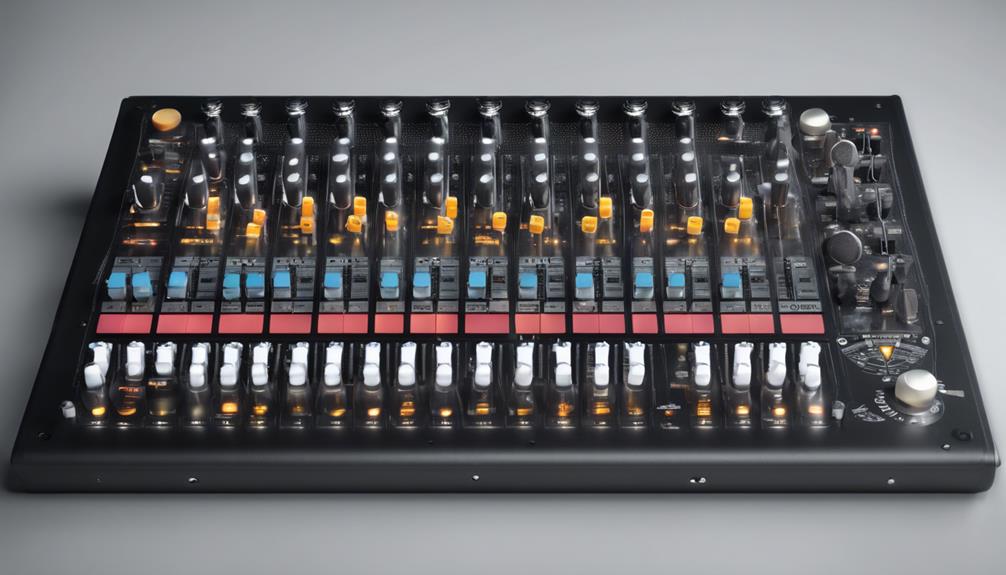
To achieve a professional and polished final mix of your mashup, utilize audio editing software to fine-tune connections and segments.
The next step is to adjust volume levels, apply equalization, and add effects to enhance the overall sound quality. Make sure to eliminate any unwanted background noise or distortions for a clean and professional final mix.
Review the entire mashup for consistency and make necessary edits or refinements before finalizing the mix. This process guarantees that your mashup is cohesive and well-balanced, offering a high-quality listening experience.
Once you're satisfied with the mix, create a high-quality audio file to share on platforms or with friends for maximum impact. By paying attention to these details and refining your mashup through careful editing, you can elevate your creation to a professional standard that showcases your skills and creativity.
Testing on Different Sound Systems
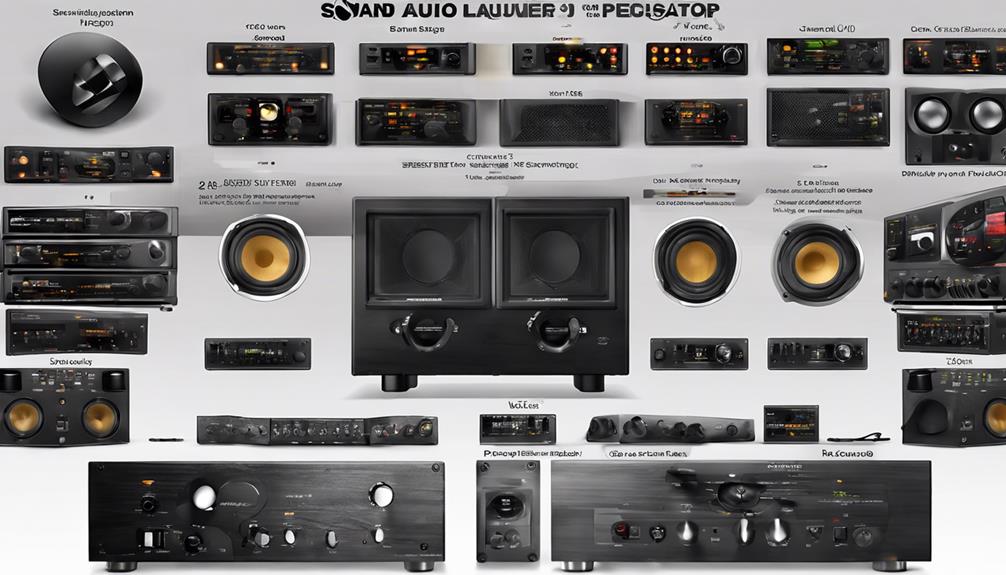
Testing mashups on various sound systems is essential for guaranteeing consistent quality across different listening environments. By conducting tests on professional studio monitors, headphones, car audio systems, and portable speakers, we can uncover any flaws or inconsistencies in the mix that may necessitate adjustments. It's vital to evaluate how the mashup sounds on both high-end and low-quality sound systems to cater to a wide audience.
Different sound systems offer diverse feedback, helping us optimize the mashup for various listening experiences. Through these tests, we can fine-tune the mix to make sure it sounds great whether played in a high-end studio or on a basic portable speaker. Adjustments made based on testing results can greatly enhance the overall quality and impact of the mashup, making it more enjoyable and engaging for listeners across different sound environments. Testing on a range of systems is a key step in perfecting the art of creating captivating and high-quality song mashups.
Seeking Feedback for Improvement

Seeking feedback from various sources is essential for improving the quality and impact of song mashups. When two songs are put together, testing them at live gigs can provide valuable insights into audience reactions, helping refine the mashups for maximum impact on the dance floor.
It's vital to refine your mashups based on audience feedback as this can elevate the overall experience for listeners and dancers alike. To guarantee a wide selection of tracks for testing and refining mashups, consider downloading necessary songs from extensive DJ pools like ZIPDJs.
Peer feedback is also invaluable; seeking input from fellow DJs, music enthusiasts, or online communities can offer diverse perspectives for enhancing your mashups. Utilizing online platforms to share your creations and gather feedback can lead to valuable insights that may inspire future improvements.
Practicing Attention to Detail
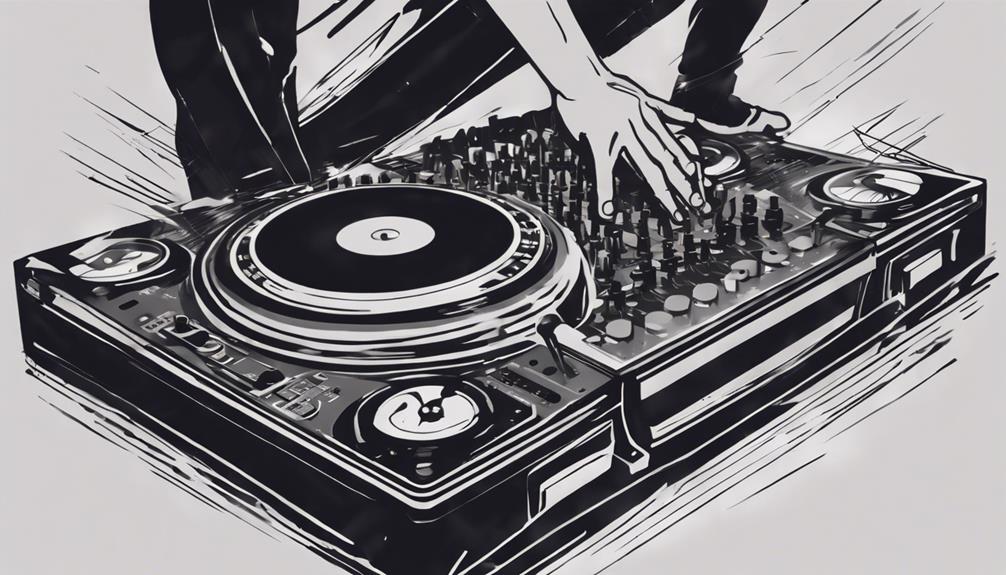
After gathering feedback for improvement, honing attention to detail in mashups involves precise matching of key and tempo, meticulous editing of connections, and careful adjustment of volume levels and equalization.
Matching the key and tempo of songs precisely is fundamental to creating a seamless blend that sounds cohesive and harmonious. By paying close attention to these details, we guarantee that the shifts between different song segments are seamless and fluid, maintaining the flow of the mashup. Additionally, meticulously adjusting volume levels and equalization can greatly enhance the overall sound quality of the final mix, bringing out the best in each song while maintaining a balanced sound throughout.
When we first started experimenting with mashups, we quickly realized the importance of removing any unwanted background noise through careful editing. This contributes to a cleaner and more professional final mix, allowing the main elements of each song to shine through without any distractions. Fine-tuning connections and song segments with precision is essential in creating a captivating and engaging mashup that keeps listeners hooked from start to finish.
Enjoying the Creative Process

Exploring the limitless domain of imagination while crafting mesmerizing mashups is an exhilarating journey filled with infinite possibilities. When it comes to enjoying the creative process of blending songs, there are key aspects to keep in mind:
- Embrace Creative Freedom: Allow yourself to break free from conventional boundaries and let your imagination run wild. Experiment with different genres and styles to uncover unique musical combinations that resonate with your vision.
- Find Joy in the Blend: Revel in the process of merging vocals and instrumentals to construct enchanting mashups. Let the harmony between different songs inspire you and fuel your creativity.
- Stay Open to Surprises: Embrace the unexpected outcomes and creative surprises that arise along the way. Sometimes the best mashups come from moments of spontaneity and experimentation. Enjoy the journey of discovery as you master the art of crafting innovative song mashups.
Frequently Asked Questions
How Do You Make a Good Mashup of Songs?
Making a good mashup of songs involves selecting tunes that match in key and tempo, blending vocal and instrumental tracks creatively, and refining connections with audio editing tools. Paying close attention to segment arrangements and flow is essential for a seamless mix.
Once you've perfected your mashup, share it on platforms like SoundCloud and YouTube to gain exposure and gather feedback. Mastering the art of mashups requires practice and a keen ear for harmonious combinations.
How Many Songs Should Be in a Mashup?
When creating a mashup, the number of songs to include depends on the complexity and vision of the final product. Some mashups might blend two tracks for simplicity, while others may incorporate elements from multiple songs for a more intricate mix.
The decision on how many songs to use is driven by creativity and innovation, from crafting a seamless blend with a few songs to constructing a multi-song masterpiece for a diverse musical experience.
What Are Good Song Mashups?
Good song mashups are blends of different tracks that harmoniously mix key and tempo for smooth shifts. They often use popular songs to appeal to a broad audience.
A well-executed mashup showcases creativity and skill, gaining recognition for its unique sound. By seamlessly merging tracks, good mashups create an innovative listening experience that captivates audiences.
These mixes highlight the artistry of the creator and can lead to increased appreciation for their work.
How Do I Know What Songs to Mashup?
When deciding on songs to mashup, we focus on harmonious keys, tempos, and engaging tracks for the audience. We blend genres and styles creatively for a unique mix.
Cohesiveness is key, ensuring smooth shifts between songs. Themes guide our selections, creating an immersive experience.
The goal is a dynamic playlist that captivates listeners and showcases our artistry.
Conclusion
In mastering the art of song mashups, we blend melodies and rhythms to create something entirely new. Just like mixing colors on a canvas, the possibilities are boundless when it comes to music.
By following these 10 simple steps, we can unleash our creativity and craft unique soundscapes that resonate with others. So let's embrace the magic of music, experiment fearlessly, and let our imaginations soar through the power of song mashups.
-
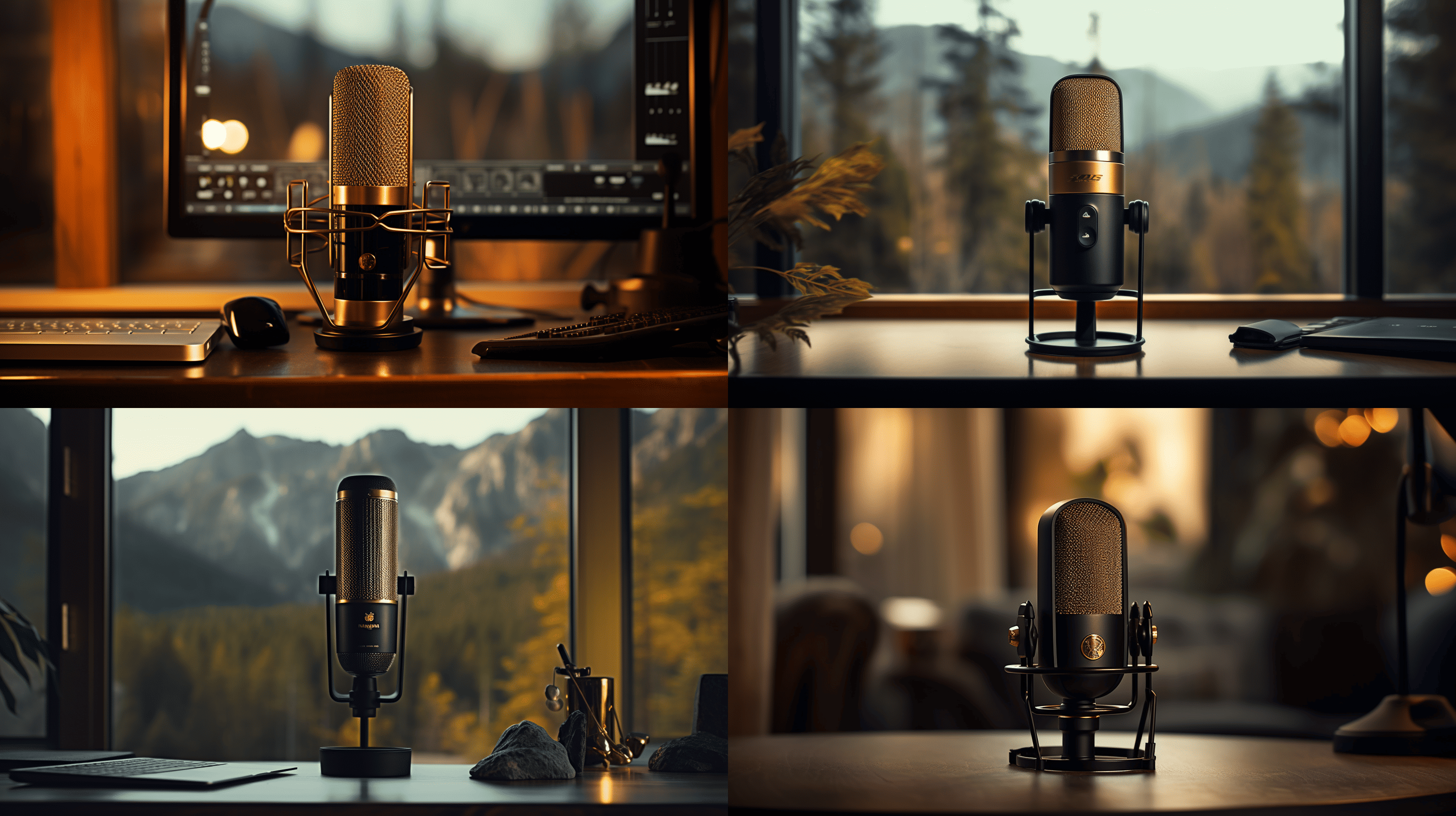
 Microphone2 months ago
Microphone2 months agoUnleash Your Inner Podcaster: Discover the Best Microphone for Crisp, Clear Audio
-

 Vetted2 weeks ago
Vetted2 weeks ago11 Best Gore Websites to Explore the Darker Side of the Internet
-

 Music Theory2 months ago
Music Theory2 months agoUnlocking Nature’s Harmony: The Power of 432 Hz Frequency in Sound & Music for Enhanced Living and Well-Being
-

 Vetted1 week ago
Vetted1 week ago15 Best Essential Oils Brands to Elevate Your Aromatherapy Experience
-

 Native Instruments Kontakt2 months ago
Native Instruments Kontakt2 months agoVOCAL AI – Animated Intelligence: The Ultimate Vocal Playground
-

 Sound Design2 months ago
Sound Design2 months agoWhat Is the Difference Between a Sound Engineer and A Sound Designer?
-

 Sound Design2 months ago
Sound Design2 months agoWhy Sound Engineer
-

 Composing2 months ago
Composing2 months agoMUTILATED NOISE by SampleTraxx: The Next Generation Sound Collection
















